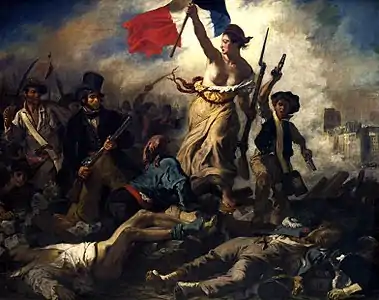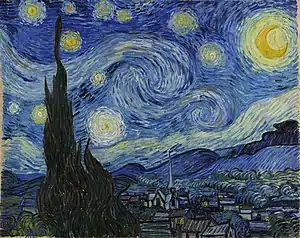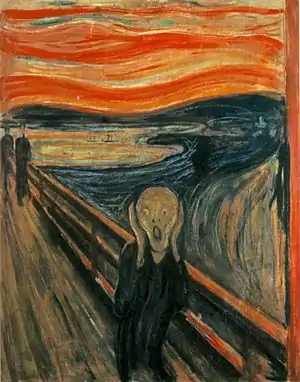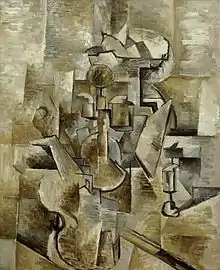Art movement
An art movement is a tendency or style in art with a specific common philosophy or goal, followed by a group of artists during a specific period of time, (usually a few months, years or decades) or, at least, with the heyday of the movement defined within a number of years. Art movements were especially important in modern art, when each consecutive movement was considered as a new avant-garde movement.
 |
| History of art |
| Art history |
Concept
According to theories associated with modernism and the concept of postmodernism, art movements are especially important during the period of time corresponding to modern art.[1] The period of time called "modern art" is posited to have changed approximately halfway through the 20th century and art made afterward is generally called contemporary art. Postmodernism in visual art begins and functions as a parallel to late modernism[2] and refers to that period after the "modern" period called contemporary art.[3] The postmodern period began during late modernism (which is a contemporary continuation of modernism), and according to some theorists postmodernism ended in the 21st century.[4][5] During the period of time corresponding to "modern art" each consecutive movement was often considered a new avant-garde.[4]
Also during the period of time referred to as "modern art" each movement was seen corresponding to a somewhat grandiose rethinking of all that came before it, concerning the visual arts. Generally there was a commonality of visual style linking the works and artists included in an art movement. Verbal expression and explanation of movements has come from the artists themselves, sometimes in the form of an art manifesto,[6][7] and sometimes from art critics and others who may explain their understanding of the meaning of the new art then being produced.
In the visual arts, many artists, theorists, art critics, art collectors, art dealers and others mindful of the unbroken continuation of modernism and the continuation of modern art even into the contemporary era, ascribe to and welcome new philosophies of art as they appear.[8][9] Postmodernist theorists posit that the idea of art movements are no longer as applicable, or no longer as discernible, as the notion of art movements had been before the postmodern era.[10][11] There are many theorists however who doubt as to whether or not such an era was actually a fact;[4] or just a passing fad.[5][12]
The term refers to tendencies in visual art, novel ideas and architecture, and sometimes literature. In music it is more common to speak about genres and styles instead. See also cultural movement, a term with a broader connotation.
As the names of many art movements use the -ism suffix (for example cubism and futurism), they are sometimes referred to as isms.
19th-, 20th- and 21st-century art movements
19th century
.jpg.webp)


 Gustave Courbet, Stone-Breakers, 1849, Realist School
Gustave Courbet, Stone-Breakers, 1849, Realist School



1900–1921
%252C_oil_on_canvas%252C_52.1_x_54.6_cm%252C_Stiftung_Sammlung_E.G._B%C3%BChrle%252C_Zurich.jpg.webp) Wassily Kandinsky, 1903, Der Blaue Reiter painting, Der Blaue Reiter 21.1 cm × 54.6 cm (8.3 in × 21.5 in)
Wassily Kandinsky, 1903, Der Blaue Reiter painting, Der Blaue Reiter 21.1 cm × 54.6 cm (8.3 in × 21.5 in)


 Georges Braque 1910, Analytic Cubism
Georges Braque 1910, Analytic Cubism.jpg.webp) Kazimir Malevich, (Supremus No. 58), Museum of Art, 1916, Suprematism
Kazimir Malevich, (Supremus No. 58), Museum of Art, 1916, Suprematism
%252C_oil_on_canvas%252C_126_x_100_cm._Private_collection.jpg.webp)
 Piet Mondrian, Tableau I, 1921, De Stijl
Piet Mondrian, Tableau I, 1921, De Stijl
|
|
1920–1945
 Theo van Doesburg, Composition XX, 1920, De Stijl
Theo van Doesburg, Composition XX, 1920, De Stijl


|
|
1940–1965

|
1965–2000
%252C_Tate_Modern%252C_London_-_20130627.jpg.webp)

 Tony Smith, She Who Must Be Obeyed, 1975, Tony Smith Department of Labour Building, Minimalism
Tony Smith, She Who Must Be Obeyed, 1975, Tony Smith Department of Labour Building, Minimalism_by_Dan_Flavin%252C_Tate_Liverpool.jpg.webp)
21st century
See also
References
- Man of his words: Pepe Karmel on Kirk Varnedoe — Passages – Critical Essay Artforum, Nov, 2003 by Pepe Karmel
- The Originality of the Avant Garde and Other Modernist Myths Rosalind E. Krauss, Publisher: The MIT Press; Reprint edition (July 9, 1986), Part I, Modernist Myths, pp.8–171
- The Citadel of Modernism Falls to Deconstructionists, – 1992 critical essay, The Triumph of Modernism, 2006, Hilton Kramer, pp 218–221.
- Post-Modernism: The New Classicism in Art and Architecture Charles Jencks
- William R. Everdell, The First Moderns: Profiles in the Origins of Twentieth-century Thought, University of Chicago Press, 1997, p4. ISBN 0-226-22480-5
- "Poetry of the Revolution. Marx, Manifestos, and the Avant-Gardes" introduction, Martin Puchner Archived 2005-12-27 at the Wayback Machine Retrieved April 4, 2006
- "Looking at Artists' Manifestos, 1945–1965", Stephen B. Petersen Archived September 27, 2011, at the Wayback Machine Retrieved April 4, 2006
- Clement Greenberg: Modernism and Postmodernism, seventh paragraph of the essay. URL accessed on June 15, 2006
- Clement Greenberg: Modernism and Postmodernism, William Dobell Memorial Lecture, Sydney, Australia, Oct 31, 1979, Arts 54, No.6 (February 1980). His final essay on modernism Retrieved October 26, 2011
- Ideas About Art by Desmond, Kathleen K. , John Wiley & Sons, 2011, p.148
- International postmodernism: theory and literary practice, Bertens, Hans , Routledge, 1997, p.236
- "The Death of Postmodernism And Beyond | Issue 58 | Philosophy Now". philosophynow.org.
- National Gallery of Art
- Willem de Kooning (1969) by Thomas B. Hess
External links
- the-artists.org Art movements since 1900.
- 20th-Century Art Compiled by Dr.Witcombe, Sweet Briar College, Virginia.
- WebMuseum, Paris Themes index and detailed glossary of art periods.